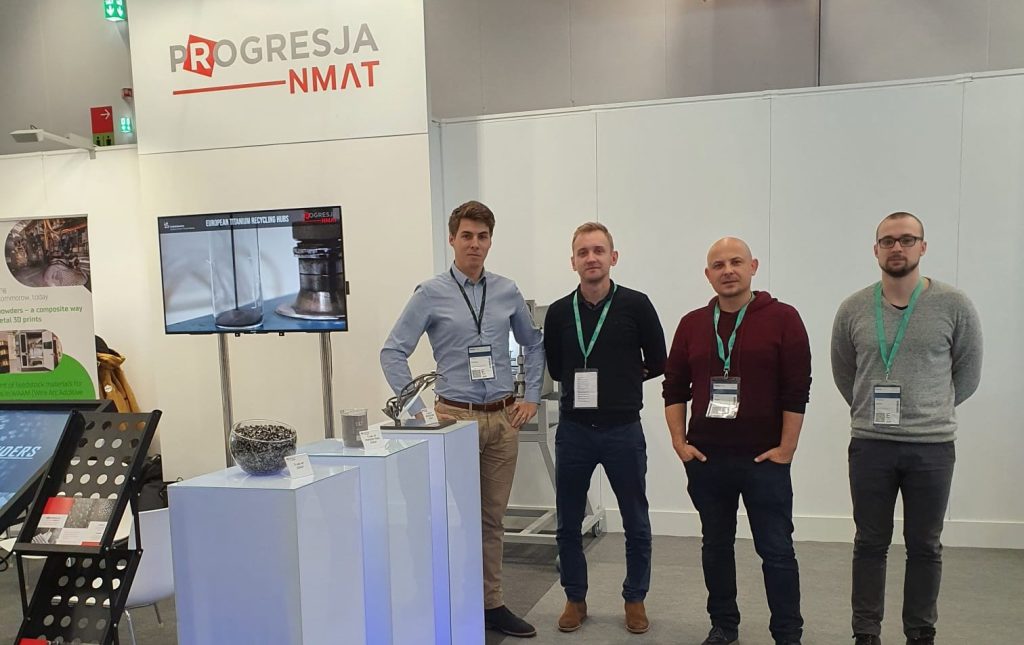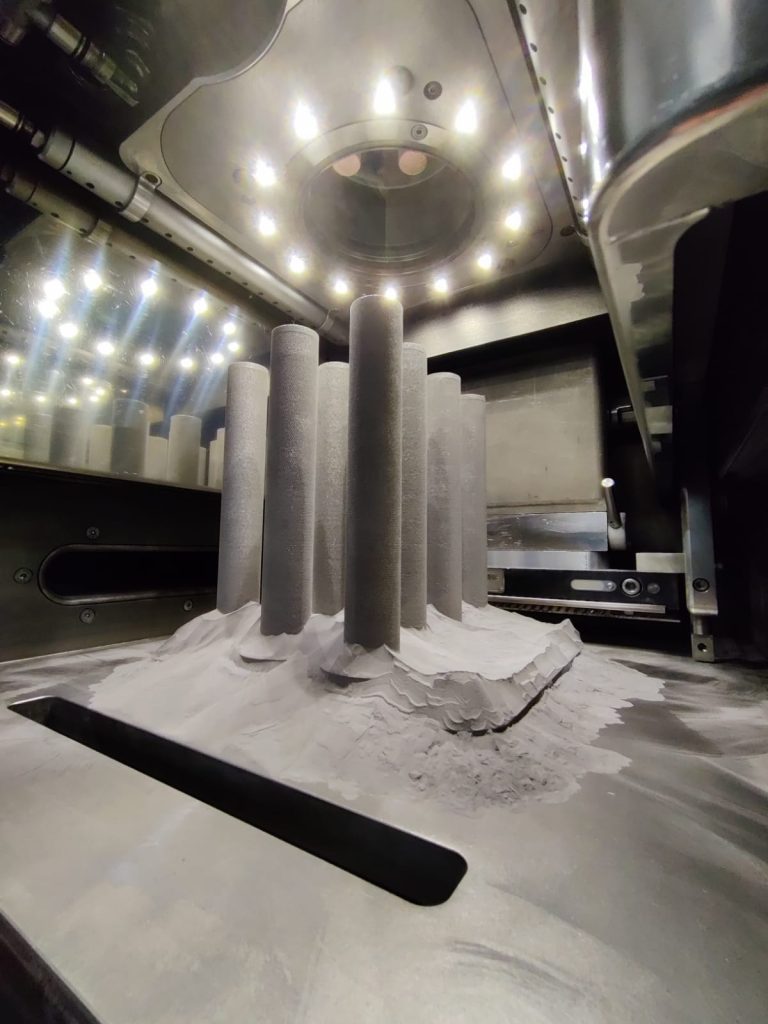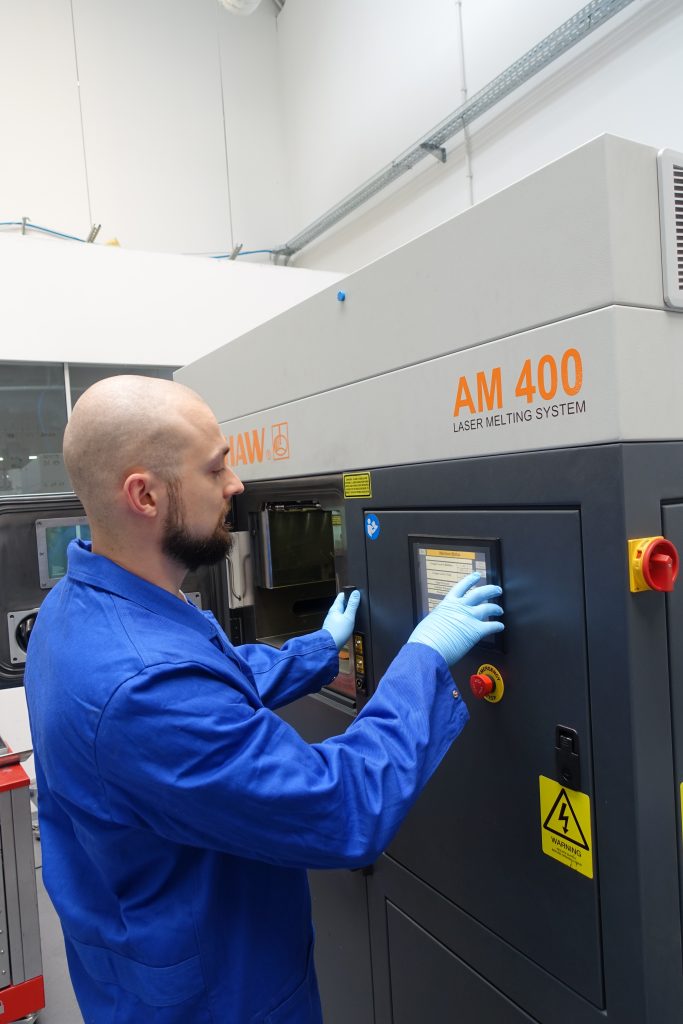Ahead of Formnext 2023, 3D Printing Industry spoke to the winners of the Formnext Start-Up challenge.
Adrian Kukofka, CEO of Progresja New Materials, route to additive manufacturing saw him initially dive into laser cladding technologies and recycling aluminum and stainless steel. A foray into titanium recycling led to Progresja New Materials, a venture dedicated to developing recycled titanium for AM applications, particularly catering to Europe’s aerospace and heavy industries.
Kukofka’s expertise has transitioned from welding to a niche in metallic manufacturing in AM, a shift reflective of his endeavor to meld the practical with the theoretical. His academic pursuits culminated in a Ph.D., focusing on projects concerning in-space in-situ manufacturing for the European Space Agency.

Tackling cost and sustainability: a vision for Additive Manufacturing
Like many start-ups, Progresja New Materials has engaged in a pivot, from early plans to address the cost of metal additive manufacturing to foregrounding the sustainability of materials used in the process. Kukofka remarked on the shift: “At the beginning, it was mostly the economic side of additive manufacturing. Our first focus was to lower the price of powders. But from the talks we have with industry, we know that more and more focus is on the sustainability.”
The narrative took a notable turn when Russia invaded Ukraine, unveiling a critical dependency of Europe on external titanium supplies, primarily from Russia and China. Recent geopolitical tensions have amplified the aerospace industry’s desire to lessen ties with traditional suppliers, augmenting the push toward establishing a self-sustaining titanium source within Europe. Kukofka notes, “Almost all the scrap produced in Europe is sent back either east or to the USA where it is recycled. Only 19% of titanium is recycled in Europe.” Progresja New Materials envisages filling this void by leveraging its knowledge in titanium recycling, aiming not just at cost reduction but a sustainable AM landscape.
Vote now in the 2023 3D Printing Industry Awards.
Bridging titanium recycling gap amid supply chain reconfigurations
Kukofka traced the issue back to Europe’s shift away from heavy industry and the subsequent outsourcing of production, mirroring the global reconfiguration of supply chains that left the continent vulnerable to external shocks. Our conversation highlighted a key technical challenge in reusing titanium scrap: managing the oxygen content to remain below 2000 PPM, a requisite for industries relying on titanium. Kukofka noted, “The main challenge is the oxygen content in titanium. That’s what drives the price up because production is energy consuming.”
Over two years, Progresja developed a technology to clean and pulverize industrial scrap, setting a foundation to produce powder for additive manufacturing (AM) technologies like selective laser melting, direct deposition, and now, binder jetting—a “rising star of additive manufacturing” as per Kukofka. He envisions that combining the cost-effectiveness of their recycled titanium with the speed of binder jetting could expedite AM adoption across various sectors beyond the stringent demands of aerospace and medical fields.
Progresja New Materials is scaling up to enhance the throughput of its titanium recycling process. Kukofka elaborates on the process, “As one of the steps of the process, we use plasma spheroidization. Right now, we’re starting to scale up this technology. Most spheroidization drives the price up, and it has a very low throughput compared to other processes.” He acknowledges the energy-intensive nature of plasma spheroidization, which constitutes half of their production process cost. The situation is exacerbated in Poland due to its high CO2 equivalent per kilowatt of energy, thrice as much as Germany’s, shedding light on the intertwined issues of operational costs and environmental impact.
With growing inquiries from clients regarding energy consumption and the source of energy in Progresja’s process, the conversation steers toward Life Cycle Analysis (LCA) and environmental accountability now demanded from companies. Kukofka envisages ‘recycling hubs’ proximate to manufacturing sites to mitigate the environmental impact associated with scrap transport. He noted, “Transport of scrap is not environmentally friendly. We are already in talks with two major European aerospace companies so they can recycle their scrap, produce the powder, and use the powder in the same facility.”
The company’s strategic roadmap is to scale up titanium recycling operations to meet burgeoning demand, particularly from the aerospace sector. Currently, Progresja New Materials can process one kilogram of titanium per hour, but with EU funding, the firm aims to construct a production line that could handle over 40 tonnes annually, marking a significant leap towards industrial-scale operations.
The technical journey involves recycling titanium scrap and managing oversized powder and failed prints from other processes to reintroduce them into the additive manufacturing (AM) lifecycle. Kukofka elaborated, “We are also developing the process to deoxidize powder from selective laser melting. Powder can get out of scope for some companies, and they can’t use it anymore. We are working with some companies right now to optimize their powder to put it back into the specification.”
Work in the aerospace sector will necessarily require navigation through the regulatory labyrinth, where material qualifications and certifications are paramount. The response to Progresja’s proposal from tightly regulated industries has been promising, driven by the dual incentive of cost-saving and securing a local titanium source. Kukofka recounted, “Last year, we were at Formnext, and on the third day, we met with two major companies. They said that this process is major for them. They want to use it because they are buying titanium bar for fifty to two hundred euros per kilo. They sell this scrap for two euros per kilo.”
In the broader spectrum, Progresja’s initiative dovetails with the European Commission’s drive to secure critical raw materials via European technologies, embodying a timely response to the industry’s call for sustainable, locally sourced materials.
The current market price for titanium powder fluctuates between 200 to 400 euros per kilogram, depending on the grade and supplier. Despite the ability to potentially undercut market prices by about 50% due to lower production costs associated with recycling, Progresja retains market-level pricing to accentuate the sustainable aspect of its offerings. Kukofka remarked, “Right now, we are not competing on price. The value is in the sustainable origin.”
The long-term vision for Progresja extends beyond just supplying recycled powder. Kukofka shared, “Our main product will not be powder; we would like to recycle as the service mostly.” This service-oriented model reflects a deeper engagement with the AM industry’s needs, providing a circular solution that re-introduces titanium scrap into the manufacturing lifecycle.

Emerging Innovations in 3D Printing
Poland is emerging as a hub for materials engineering innovations, particularly in the burgeoning 3D printing and titanium recycling sectors. Kukofka, CEO of Progresja New Materials, attributes this to a strong pool of engineering talent in the country. He mentions, “We have some really good materials engineers in Poland. We have young engineers who would like to do something big. They see the 3D printing industry as a rising industry. Our extensive scientific infrastructure is also a vital asset. In our case, collaborating closely with the Łukasiewicz Research Network – Institute of Non-Ferrous Metals was indispensable for the fast assessment and advancement of our technology.”
While acknowledging that Poland may lag behind Western Europe in certain aspects of the additive manufacturing (AM) sector, Kukofka highlights a unique advantage: the willingness to venture into uncharted territory with novel ideas. This appetite for innovation is further fueled by the AM sector’s openness to exploring new materials. Kukofka notes, “A lot of companies are still taking chances. There’s a higher chance that your material will be tested in additive manufacturing than in any other technology.” This conducive environment propels companies like Progresja New Materials to develop and test new concepts, subsequently contributing to the global narrative of circular economy in AM.
Moreover, Kukofka hints at a reverse brain drain phenomenon, with engineers returning to Poland, further enriching the country’s talent pool. This, coupled with a drive to “start from the bottom” and work up in unexplored niches, underscores Poland’s potential as a hotbed for AM and materials engineering innovations.
Kukofka underscored the potential partnerships with major aerospace or metallurgical companies in Western Europe post the successful launch of the maiden manufacturing plant in Poland. He said, “If successful, this first manufacturing plant in Poland, then we will move to starting the next one somewhere in Western Europe with one of the aerospace companies or metallurgical company.” This move is a part of their broader vision to establish recycling hubs across Europe.
The firm’s immediate future also sees them reaching out for venture capital to bridge the funding gap for the proposed project. The grant they are eyeing covers 80% of the required funding, leaving them to source the remaining 20%, translating to about €1 to €1.5 million. Kukofka revealed, “We currently are not VC funded in any way… so we will be most probably looking for funding from VCs to develop this technology further,” as they prepare to exhibit at Formnext, anticipating connections that could fuel their expansion journey.
The narrative underscores a blend of public and private financing channels being pursued by Progresja New Materials to pioneer sustainable titanium recycling solutions in the additive manufacturing landscape, reflecting a wider trend in the sector toward sustainability and circular economy.
Make sure to visit Progresja New Materials during Formnext 2023; find them in the Startup Area at booth 12.0 B81K

What does the future of 3D printing for the next ten years hold?
What engineering challenges will need to be tackled in the additive manufacturing sector in the coming decade?
To stay up to date with the latest 3D printing news, don’t forget to subscribe to the 3D Printing Industry newsletter or follow us on Twitter, or like our page on Facebook.
While you’re here, why not subscribe to our Youtube channel? Featuring discussion, debriefs, video shorts, and webinar replays.
Are you looking for a job in the additive manufacturing industry? Visit 3D Printing Jobs for a selection of roles in the industry.
Featured image shows the Progresja New Materials team (from the left, Adrian Kukofka, Krzysztof Fryzowicz, Dawid Ślizak, Radosław Bardo). Photo via Progresja New Materials.
.



